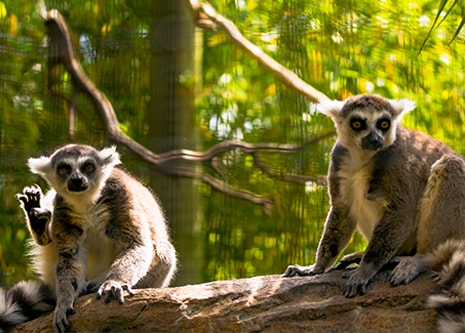
- VisitSupport Happy HollowDONATE TODAYExploreSupport Happy HollowDONATE TODAYLearnSupport Happy HollowDONATE TODAYSupportToday’s Hours: CLOSEDZoo in the Hollow
Capuchin monkey
Scientific name: Cebus spp.
Family: Cebidae
Order: Primates
Class: Mammalia
Range: Central and South America
Habitat: Rainforests and forests
Lifespan: 15 to 25 years in the wild; up to 45 years in captivityHow do they behave?
Capuchin monkeys are diurnal and arboreal. They are social animals and live in groups of up to 35 members. A group usually consists of related females, their offspring, and a couple of adult males. They will spend time each day grooming each other to build social bonds. Capuchins are territorial and maintain their territories by urine marking and physical defense against intruders. In their dense forest homes, vocal communication is a must. They will scream, chatter or bark to express warning, disturbances or their location.What do they eat?
Capuchins have highly variable diets. They are omnivores and will eat fruits, nuts, seeds, insects, spiders, eggs, shellfish and small vertebrates. At Happy Hollow, they eat a specialized primate diet, fruits and vegetables.How are they born?
Capuchins breed year-round. Females reach maturity by the time they are four years of age, while males are not ready to breed until eight years old. Females have a 160 to 180 day gestation period which nearly always results in a single baby. Females will produce young once every two years. The mortality rate is very high for the first two years of life. Young capuchin monkeys will cling to their mother’s chest until strong enough to cling to her back. They will eat on their own by around four months old. Males rarely participate in rearing their offspring.How smart are they?
Capuchins are considered the most intelligent of the New World monkeys. They will collect rocks, store them, and use them as tools to open hard nuts and shellfish. These monkeys learn techniques from their parents and older members of the group, and it can take years to master these skills. In captivity, capuchins require constant enrichment to keep them mentally and physically fit.Do monkeys make good pets?
In most states, it is illegal to privately own primates. However, even in states that do not have legal restrictions, monkeys do not make good household pets. Caring for a monkey is a huge commitment and best left to highly trained professionals. They require a high degree of care, specialized diets, extensive mental and physical stimulation, and upon reaching adulthood, monkeys naturally compete for the “alpha” position in the family and are prone to aggression. Monkeys have relatively long life spans and cannot go without care if life gets busy or when circumstances change. They also do not adapt well to new people (such as friends, significant others, and children) which can affect human relationships. In short, it’s best to enjoy monkeys in their natural habitats in the wild or at the zoo.Conservation
Six species are stable; three are critically endangered.What do they look like?
Capuchins are lean, agile monkeys. They generally weigh two to three pounds and are 12 to 22 inches long, head to rump; their tails are about as long as their body length and are prehensile, which means they can hold on to branches and act as a fifth limb. Coloration varies by species, though their backs, arms, legs and tails are typically brown or black in color while their faces, necks, and chests are lighter in color. They have flat faces with forward facing eyes, rounded ears and opposable thumbs.
Zoo on the Hill
Located across from the Keep-Around Carousel is the Zoo on the Hill. Learn about wildlife up close during daily meet-and-greets, leap like a lemur on the playground, brush and feed the goats,, or take a peek inside Doc’s Critter Care building and the Ranch House. Double-H Ranch features a combination of animal exhibits, including giant anteaters and red ruffed lemurs, as well chickens and domesticated animals that are docile enough to touch.
See Animals
Education Ambassadors
From camps and classes to scout badges and sleepovers, Happy Hollow education programs have something for everyone! The zoo education program offers a broad range of hands-on, engaging programs and public presentations featuring education ambassador animals. These encounters are designed to connect you to wildlife and the conservation of their habitats around the world.
See AnimalsVisit Us Today
Plan an unforgettable experience at San Jose’s family-friendly park and zoo.
Learn More